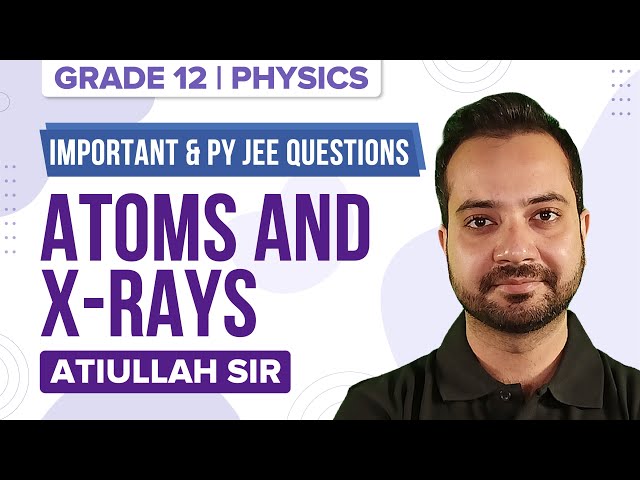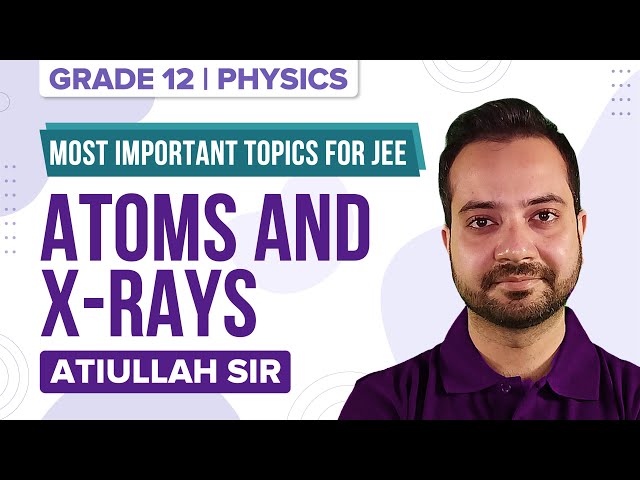We can define X-Rays as a form of electromagnetic radiation. They are powerful waves of electromagnetic energy. They have an extremely short wavelength ranging from 10-8 to 10-12 metres, with high frequencies in the range of 1016 to 1020 hertz. X-rays are used for various purposes like medical science, security, astronomy etc.
Download X Rays JEE Advanced Previous Year Questions With Solutions PDF
Question 1) An electron having the de Broglie wavelength λ falls on an X-ray tube. The cut-off wavelength of emitted X-ray is
(A) 2mcλ2/h
(B) 2h/mc
(C) h/mc
(D) 2mcλ2/3h
Answer: (A)
Solution:

Question 2) If λcu is the wavelength of Kα X-ray line of copper (atomic number 29) and λMO is the wavelength of the Kα X-ray line of molybdenum (atomic number 42), then the ratio is close to:
(A) 1.99
(B) 2.14
(C) 0.50
(D) 0.48
Answer: (B) 2.14
Solution:
The relation between λ and Z is given by
Question 3) Which one of the following statements is Wrong in the context of X-rays generated from an X-ray tube?
(A) Wavelength of characteristic X-ray decreases when the atomic number of the target increases.
(B) Cut-off wavelength of the continuous X-rays depends on the atomic number of the target.
(C) Intensity of the characteristic X-rays depends on the electrical power given to the X-ray tube.
(D) Cut-off wavelength of the continuous X-ray depends on the energy of the electrons in the X-ray tube.
Answer: (B) Cut-off wavelength of the continuous X-rays depends on the atomic number of the target.
Solution:
The wavelength of continuous X-rays is independent of the atomic number of the target material.
Question 4) Electrons with de-Broglie wavelength λ fall on the target in an X-ray tube. The cut-off wavelength of the emitted X-rays is
(A) λ0 = 2mcλ2/h
(B) λ0 = 2h/mc
(C) λ0 = 2m2c2λ3/h2
(D) λ0 = λ
Answer: (A) λ0 = 2mcλ2/h
Solution:
The cut off wavelength of the emitted X-ray,
λ0 = hc/eV ________(1)
According to de Broglie equation
λ = h/p = h/√2meV
λ2 = h2/2meV
⇒ V = h2/2meλ2 _______ (2)
From equation (1) and (2),
Question 5) The X-ray beam coming from an X-ray tube will be
(A) Monochromatic
(B) having all wavelengths smaller than a certain minimum wavelength
(C) having all wavelengths larger than a certain minimum wavelength
(D) having all wavelengths lying between a minimum and a maximum wavelength
Answer: (C) having all wavelengths larger than a certain minimum wavelength
Solution:
Cutt-off wavelength, λmin = hc/eV
Question 6) The shortest wavelength of X-rays emitted from tube depends on
(A) The current in the tube
(B) The voltage applied to the tube
(C) The nature of the gas in tube
(D) The atomic number of the target material
Answer: (B) The voltage applied to the tube
Solution:
The shortest wavelength of X-rays emitted from tube depends on the voltage applied to the tube
Question 7) The potential difference applied to an X-ray tube is 5kV and the current through it is 3.2 mA. Then the number of electrons striking the target per second is
(A) 2 x 1016
(B) 5 x 106
(C) 1 x 1017
(D) 4 x 1015
Answer: (A) 2 x 1016
Solution:
As we know , I = q/t = ne/t
Number of electrons striking the target per second
⇒ (n/t) = I/e = (3.2 x 10-3)/(1.6 x 10-19)
= 2 x 1016
Question 8) Electrons with energy 80keV are incident on the tungsten target of an X-ray tube. K-shell electrons of tungsten have 72.5 keV energy. X-rays emitted by the tube contain only
(A) A continuous X-ray spectrum (Bremsstrahlung) with a minimum wavelength of ~0.155 Å
(B) A continuous X-ray spectrum (Bremsstrahlung) with all wavelengths
(C) The characteristics X-ray spectrum of tungsten
(D) A continuous X-ray spectrum (Bremsstrahlung) with a minimum wavelength of ~0.155 Å and a characteristic X-ray spectrum of tungsten.
Answer: (D) A continuous X-ray spectrum (Bremsstrahlung) with a minimum wavelength of ~0.155 Å and a characteristic X-ray spectrum of tungsten.
Solution:
Energy = hc/λ
λ = hc/energy
= (1240 eV-nm)/(80 x 103 eV)
= 0.0155 nm
= 0.155 Å
So, X-rays emitted have a continuous X-ray spectrum with a minimum wavelength of 0.155 Å and a characteristic X-ray spectrum of tungsten because electrons are incident on a tungsten target.
Question 9) In an X-ray tube, electrons accelerated through a potential difference of 15,000 volts strike a copper target. The speed of the emitted X-ray inside a tube is ______ m/s.
Answer: 3 x 108 m/s
Solution:
Since X-ray is an electromagnetic radiation, the speed of the emitted X-rays inside the tube will be the speed of light.
Question 10) When the number of electrons striking the anode of an X-ray tube is increased, the ______ of the emitted X-rays increases, while when the speed of the electrons striking the anode is increased, the cut-off wavelength of the emitted X-ray _______
Answer: intensity, decreases
Solution:
More the number of electrons striking the anode, more the number of photons of X-rays emitted. Hence more is the intensity of X-rays.
When the speed of the striking electrons on anode is increased, the emitted X-rays have greater energy. And energy, E = hc/λ. Therefore, when E increases then λ decreases.
Also Read:
Electromagnetic Wave JEE Main Previous Year Questions With Solutions
Video Lessons
Atoms and X-Rays – Important Questions

Atoms and X-Rays – Important Topics

Comments